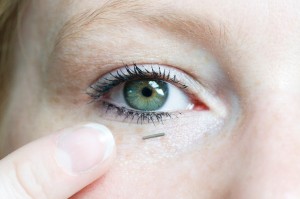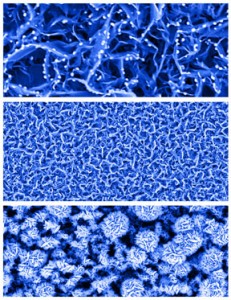About 10 years ago, I got interested in how the arts and sciences can inform each other when I was trying to organize an art/science event which never did get off the ground (although I still harbour hopes for it one day). It all came back to me when I read Dave Bruggeman’s (Pasco Phronesis blog) recent post about a new Creative Science Studio opening at the School of Cinematic Arts at the University of Southern California (USC). From Dave’s post,
It [Creative Science Studio] will start this fall at USC, where its School of Cinematic Arts makes heavy use of its proximity to Hollywood, and builds on its history of other projects that use science, technology and entertainment in other areas of research.
The studio will not only help studios improve the depiction of science in the products of their students, faculty and alumni (much like the Science and Entertainment Exchange), but help scientists create entertaining outreach products. In addition, science and engineering topics will be incorporated into the School’s curriculum and be supported in faculty research.
This announcement reminds me a little bit of an IBM/USC initiative in 2008 (from the news item on Nanowerk),
For decades Hollywood has looked to science for inspiration, now IBM researchers are looking to Hollywood for new ideas too.
The entertainment industry has portrayed possible future worlds through science fiction movies – many created by USC’s famous alumni – and IBM wants to tap into that creativity.
At a kickoff event at the USC School of Cinematic Arts, five of IBM’s top scientists met with students and alumni of the school, along with other invitees from the entertainment industry, to “Imagine the World in 2050.” The event is the first phase of an expected collaboration between IBM and USC to explore how combining creative vision and insight with science and technology trends might fuel novel solutions to the most pressing problems and opportunities of our time.
It’s interesting to note that the inspiration is two-way if the two announcements are taken together. The creative people can have access to the latest science and technology work for their pieces and scientists can explore how an idea or solution to a problem that exists in a story might be made real.
I’ve also noted that the first collaboration mentioned suggests that the Creative Science Studio will be able to “help scientists create entertaining outreach products.” My only caveat is that scientists too often believe that science communication means that they do all the communicating while we members of the public are to receive their knowledge enthusiastically and uncritically.
Moving on to the math that I mentioned in the head, there’s an announcement of a new paper that discusses the use of mathematics in cinematic special effects. (I believe that the word cinematic is starting to include games and other media in addition to movies.) From the news item on physorg.com,
The use of mathematics in cinematic special effects is described in the article “Crashing Waves, Awesome Explosions, Turbulent Smoke, and Beyond: Applied Mathematics and Scientific Computing in the Visual Effects Industry”, which will appear in the May 2010 issue of the NOTICES OF THE AMS [American Mathematical Society]. The article was written by three University of California, Los Angeles, mathematicians who have made significant contributions to research in this area: Aleka McAdams, Stanley Osher, and Joseph Teran.
Mathematics provides the language for expressing physical phenomena and their interactions, often in the form of partial differential equations. These equations are usually too complex to be solved exactly, so mathematicians have developed numerical methods and algorithms that can be implemented on computers to obtain approximate solutions. The kinds of approximations needed to, for example, simulate a firestorm, were in the past computationally intractable. With faster computing equipment and more-efficient architectures, such simulations are feasible today—and they drive many of the most spectacular feats in the visual effects industry.
This news item too brought back memories. There was a Canadian animated film, Ryan, which both won an Academy Award and involved significant collaboration between a mathematician and an animator. From the MITACS (Mathematics of Information Technology and Complex Systems) 2005 newsletter, Student Notes:
Karan Singh is an Associate Professor at the University of Toronto, where co-directs the graphics and HCI lab, DGP. His research interests are in artist driven interactive graphics encompassing geometric modeling, character animation and non-photorealistic rendering. As a researcher at Alias (1995-1999), he architected facial and character animation tools for Maya (Technical Oscar 2003). He was involved with conceptual design and reverse engineering software at Paraform (Academy award for technical achievement 2001) and currently as Chief Scientist for Geometry Systems Inc. He has worked on numerous film and animation projects and most recently was the R+D Director for the Oscar winning animation Ryan (2005)
Someone at Student Notes (SN) goes on to interview Dr. Singh (here’s an excerpt),
SN: Some materials discussing the film Ryan mention the term “psychorealism”. What does this term mean? What problems does the transition from realism to psychorealism pose for the animator, or the computer graphics designer?
KS: Psychorealism is a term coined by Chris {Landreth, film animator] to refer to the glorious complexity of the human psyche depicted through the visual medium of art and animation. The transition is not a problem, psychorealism is stylistic, just a facet to the look and feel of an animation. The challenges lies in the choice and execution of the metaphorical imagery that the animator makes.
Both the article and Dr. Singh’s page are well worth checking out, if the links between mathematics and visual imagery interest you.
Research on the African continent
Last week I received a copy of Thompson Reuters Global Research Report Africa. My hat’s off to the authors, Jonathan Adams, Christopher King, and Daniel Hook for including the fact that Africa is a continent with many countries, many languages, and many cultures. From the report, (you may need to register at the site to gain access to it but the only contact I ever get is a copy of their newsletter alerting me to a new report and other incidental info.), p. 3,
More than 50 nations, hundreds of languages, and a welter of ethnic and cultural diversity. A continent possessed of abundant natural resources but also perennially wracked by a now-familiar litany of post-colonial woes: poverty, want, political instability and corruption, disease, and armed conflicts frequently driven by ethnic and tribal divisions but supplied by more mature economies. OECD’s recent African Economic Outlook sets out in stark detail the challenge, and the extent to which current global economic problems may make this worse …
While they did the usual about challenges, the authors go on to add this somewhat contrasting information.
Yet the continent is also home to a rich history of higher education and knowledge creation. The University of Al-Karaouine, at Fez in Morocco, was founded in CE 859 as a madrasa and is identified by many as the oldest degree-awarding institution in the world.ii It was followed in 970 by Al-Azhar University in Egypt. While it was some centuries before the curriculum expanded from religious instruction into the sciences this makes a very early marker for learning. Today, the Association of African Universities lists 225 member institutions in 44 countries and, as Thomson Reuters data demonstrate, African research has a network of ties to the international community.
A problem for Africa as a whole, as it has been for China and India, is the hemorrhage of talent. Many of its best students take their higher degrees at universities in Europe, Asia and North America. Too few return.
I can’t speak for the details included in the report which appears to be a consolidation of information available in various reports from international organizations. Personally, I find these consolidations very helpful as I would never have the time to track all of this down. As well, they have created a graphic which illustrates research relationships. I did have to read the analysis in order to better understand the graphic but I found the idea itself quite engaging and as I can see (pun!) that as one gets more visually literate with this type of graphic that it could be a very useful tool for grasping complex information very quickly.
Diabetes and mice
Last week, I missed this notice about a Canadian nanotechnology effort at the University of Calgary. From the news item on Nanowerk,
Using a sophisticated nanotechnology-based “vaccine,” researchers were able to successfully cure mice with type 1 diabetes and slow the onset of the disease in mice at risk for the disease. The study, co-funded by the Juvenile Diabetes Research Foundation (JDRF), provides new and important insights into understanding how to stop the immune attack that causes type 1 diabetes, and could even have implications for other autoimmune diseases.
The study, conducted at the University of Calgary in Alberta, Canada, was published today [April 8, 2010?] in the online edition of the scientific journal Immunity.
NANO Magazine
In more recent news, NANO Magazine’s new issue (no. 17) features a country focus on Canada. From the news item on Nanowerk,
In a special bumper issue of NANO Magazine we focus on two topics – textiles and nanomedicine. We feature articles about textiles from Nicholas Kotov and Kay Obendorf, and Nanomedicine from the London Centre for Nanotechnology and Hans Hofstraat of Philips Healthcare and an interview with Peter Singer, NANO Magazine Issue 17 is essential reading, www.nanomagazine.co.uk.
…
The featured country in this issue is Canada [emphasis mine], notable for its well funded facilities and research that is aggressively focused on industrial applications. Although having no unifying national nanotechnology initiative, there are many extremely well-funded organisations with world class facilities that are undertaking important nano-related research.
I hope I get a chance to read this issue.
Poetry on Bowen Island
Heather Haley, a local Vancouver, BC area, poet is hosting a special event this coming Saturday at her home on Bowen Island. From the news release,
VISITING POETS Salon & Reading
Josef & Heather’s Place
Bowen Island, BC
7:30 PM
Saturday, April 17, 2010
PENN KEMP, inimitable sound poet from London, Ontario
The illustrious CATHERINE OWEN from Vancouver, BC
To RSVP and get directions please email hshaley@emspace.com
Free Admission
Snacks & beverages-BYOB
Please come on over to our place on the sunny south slope to welcome these fabulous poets, hear their marvelous work, *see* their voices right here on Bowen Island!
London, ON performer and playwright PENN KEMP has published twenty-five books of poetry and drama, had six plays and ten CDs produced as well as Canada’s first poetry CD-ROM and several videopoems. She performs in festivals around the world, most recently in Britain, Brazil and India. Penn is the Canada Council Writer-in-Residence at UWO for 2009-10. She hosts an eclectic literary show, Gathering Voices, on Radio Western, CHRWradio.com/talk/gatheringvoices. Her own project for the year is a DVD devoted to Ecco Poetry, Luminous Entrance: a Sound Opera for Climate Change Action, which has just been released.

CATHERINE OWEN is a Vancouver writer who will be reading from her latest book Frenzy (Anvil Press 09) which she has just toured across the entirety of Canada. Her work has appeared in international magazines, seen translation into three languages and been nominated for honours such as the BC Book Prize and the CBC Award. She plays bass and sings in a couple of metal bands and runs her own tutoring and editing business.
I have seen one of Penn Kemp’s video poems. It was at least five years ago and it still resonates with me . Guess what? I highly recommend going if you can. If you’re curious about Heather and her work, go here.

